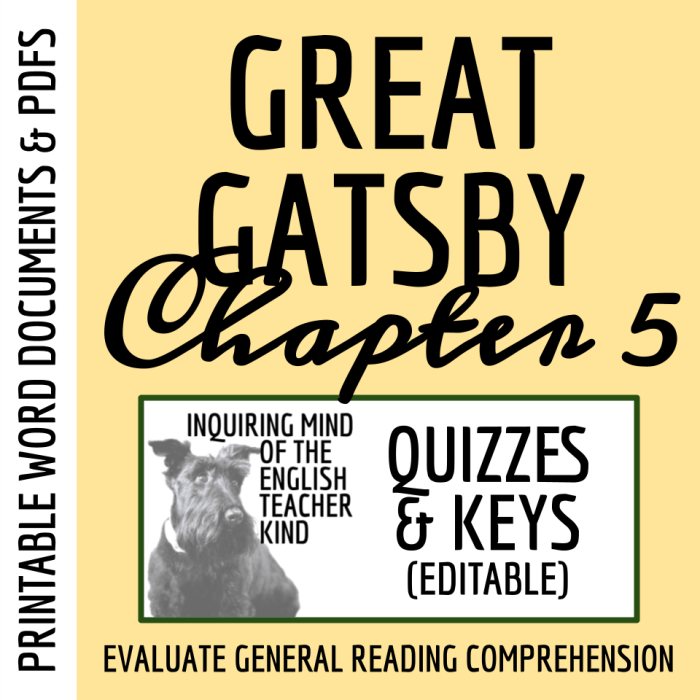The great gatsby chapter 5 questions and answers pdf – Dive into the enigmatic world of F. Scott Fitzgerald’s The Great Gatsby with our comprehensive PDF guide to Chapter 5. This chapter delves into pivotal character development, explores the lavish setting, and unravels the complexities of love, wealth, and the American Dream.
Join us as we navigate the intricacies of this literary masterpiece.
Character Development
The return of Daisy to Gatsby’s life signifies a pivotal moment in the novel. Gatsby’s long-held dream of reuniting with her is realized, but it also brings about unforeseen consequences and challenges.
The Evolving Relationship between Gatsby and Tom
- Gatsby’s initial attempts to win Daisy back are marked by lavish gestures and extravagant parties.
- However, Tom remains a formidable obstacle, using his wealth and influence to maintain control over Daisy.
- The rivalry between Gatsby and Tom escalates, leading to a confrontational dinner party and the eventual tragedy.
The Motivations and Actions of Jordan Baker
Jordan Baker is a complex and enigmatic character whose actions play a significant role in the novel’s events.
- Her cynicism and detachment reflect the disillusionment of the Jazz Age.
- She becomes a confidante to both Daisy and Gatsby, but her motives remain ambiguous.
- Her revelation about Daisy’s true feelings for Gatsby sets in motion the events leading to the novel’s tragic conclusion.
Setting and Atmosphere

The Lavish Setting of Gatsby’s Mansion
Gatsby’s mansion is a symbol of his wealth and ambition. It is a place of excess and extravagance, where parties and gatherings become a means of escaping reality.
- The grandeur of the mansion reflects Gatsby’s desire to impress Daisy and prove his worthiness.
- However, it also creates a sense of superficiality and isolation.
- The mansion becomes a stage for Gatsby’s dreams and aspirations, but it also foreshadows his tragic downfall.
Weather and Seasons
The weather and seasons play a crucial role in creating the novel’s atmosphere.
- The hot summer days reflect the intensity of Gatsby’s emotions and the fading of the American Dream.
- The rainy and stormy nights symbolize the turmoil and uncertainty of the characters’ lives.
- The changing seasons mirror the passage of time and the characters’ evolving relationships.
Symbolism of the Green Light, The great gatsby chapter 5 questions and answers pdf
The green light at the end of Daisy’s dock is a powerful symbol in the novel.
- It represents Gatsby’s hope and longing for Daisy.
- It is a reminder of the past and the impossibility of recapturing it.
- The green light ultimately becomes a symbol of Gatsby’s tragic pursuit of an unattainable dream.
Themes and Motifs: The Great Gatsby Chapter 5 Questions And Answers Pdf
Central Themes
- Love: The novel explores the nature of love, its power to both inspire and destroy.
- Wealth: Gatsby’s pursuit of wealth is a reflection of the materialism and excess of the Jazz Age.
- The American Dream: The novel examines the elusive nature of the American Dream and the price people pay in pursuit of it.
Imagery and Symbolism
Fitzgerald uses imagery and symbolism throughout the novel to convey its themes.
- The Valley of Ashes represents the moral decay and disillusionment of society.
- The eyes of Dr. T. J. Eckleburg symbolize the watchful gaze of God or a higher power.
- The broken glasses at the end of the novel represent the shattered dreams and lost illusions of the characters.
Illusion versus Reality
The novel explores the contrast between illusion and reality.
- Gatsby creates an elaborate facade to conceal his true identity.
- Daisy clings to an idealized version of the past.
- The characters’ illusions ultimately lead to their downfall.
Narrative Structure and Style
Flashbacks and Foreshadowing
The novel uses flashbacks and foreshadowing to create a sense of mystery and suspense.
- Flashbacks reveal the characters’ pasts and motivations.
- Foreshadowing hints at the tragic events that will unfold.
- The combination of flashbacks and foreshadowing creates a complex and engaging narrative structure.
Nick Carraway as the Narrator
Nick Carraway is the novel’s narrator. His perspective as an outsider provides a unique vantage point on the events of the novel.
- Nick’s objectivity allows him to observe and comment on the characters and their actions.
- However, his own biases and limitations shape his narrative.
- Nick’s role as the narrator adds depth and complexity to the novel.
Fitzgerald’s Writing Style
Fitzgerald’s writing style is characterized by its lyrical prose and vivid imagery.
- He uses sensory details to create a rich and immersive atmosphere.
- His language is often evocative and poetic.
- Fitzgerald’s writing style contributes to the novel’s overall tone and impact.
Historical and Cultural Context
Jazz Age
The novel is set during the Jazz Age, a period of economic prosperity and social change in the United States.
- The novel captures the excesses and disillusionment of the era.
- The Jazz Age provides a backdrop for the characters’ pursuit of wealth and happiness.
- Fitzgerald’s novel reflects the cultural and social shifts of the time.
Social and Economic Factors
The novel explores the influence of social and economic factors on the characters’ lives.
- The class divide between the wealthy elite and the working class is a major theme.
- The novel also examines the role of gender and race in society.
- Fitzgerald’s characters are shaped by the social and economic realities of their time.
Post-World War I Disillusionment
The novel reflects the disillusionment that followed World War I.
- The characters are haunted by the war and its aftermath.
- The novel explores the loss of innocence and the search for meaning in a postwar world.
- Fitzgerald’s novel captures the mood of a generation disillusioned with the promises of the past.
FAQ Insights
What is the significance of Daisy’s return to Gatsby’s life?
Daisy’s return rekindles Gatsby’s hopes and dreams, setting the stage for a complex and ultimately tragic love triangle.
How does the relationship between Gatsby and Tom evolve in this chapter?
Their rivalry intensifies, as Gatsby becomes more determined to win Daisy back and Tom grows increasingly possessive and insecure.
What motivates Jordan Baker’s actions and behavior?
Jordan is driven by a desire for control and a cynical view of relationships, which influences her interactions with Nick and Daisy.
